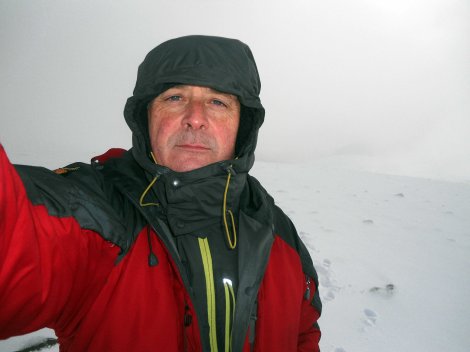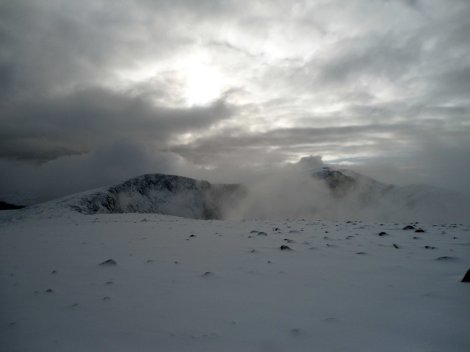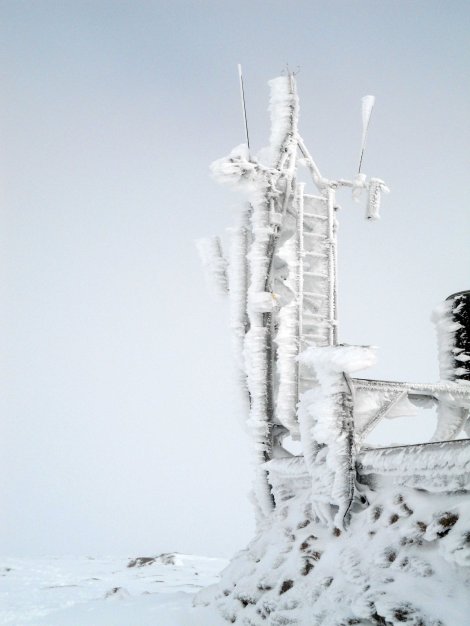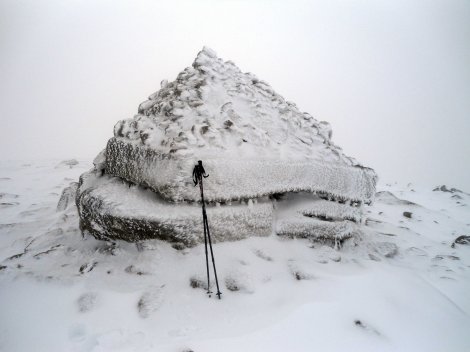As someone once said, “There is a fine line between courage and lunacy.” Those are the words that come into my mind as I stand in the car park at Cairngorm Mountain and try and summon the determination to head up into the darkening clouds that shroud the artic wonder of the Cairngorm plateau. On reflection none of the above is true. I think what someone actually said was, “There is a fine line between genius and madness.” Although, looking at the weather swirl about the car park, like an angry Grizzly bear looking for someone not to like, it’s the miss-quote that seems to make more sense.
The words “artic wonder” also require a little further analysis. The rolling summits of the Cairngorms are the only places in Britain, apart from Union Street in Aberdeen and the heart of my editor, where it is cold enough to be a truly artic environment. When you think of artic you imagine polar bears romping happily amongst stunningly beautiful icebergs whilst David Attenburgh whispers his adoration. The reality, however, is often different. Far from being hidden behind a snowy lump Attenburgh is probably in a studio in Birmingham and could shout as loud as he wanted to without disturbing the polar bears. For their part I suspect the bears have terrible bad breath and would prove a lot less cuddly if, say, you were to invite one for tea.
It’s early November in the Cairngorms, a time that holds mountaineers and skiers transfixed awaiting the arrival of the snow. Weather forecasts are followed avidly and prayers sent up for the arrival of the white stuff. The hills of Scotland, and especially the Cairngorms, come alive in winter. They are transformed from low altitude insignificant hills to mountains worth the name. In winter Scotland’s mountains show their teeth.
Follow this blog on Facebook https://www.facebook.com/johndburnsblog
When I drove down from Inverness I had a plan to walk over the high plateau of cairngorm, over Ben MacDui and on down to the Hutcheson memorial hut where I would spend a cosy night in glorious isolation. Now that I can see monstrous clouds enveloping the summit of the mountain that plan is rapidly losing its appeal. “I won’t see anything, what’s the point?” I tell myself. The lack of view, however, isn’t the real concern, in the back of my mind there is a niggling worry about navigating, alone, that far, in zero visibility, across a huge and largely featureless high plateau.
Most folk who visit the Northern Cairngorms never stray far from the cliffs of the corries at the edge of the mountains. Theses windblown edges, beloved of fledging winter climbers, offer a sort of handrail of security. It’s really impossible to get lost if you can keep these in view. Well, almost impossible. The classic Cairngorm navigation error is to confuse north and south and go 180 degrees in the wrong direction. Something it’s surprisingly easy to do. In Wales or the Lake District this can be inconvenient, you might find yourself coming down in the wrong valley, having to spend time in a pub you didn’t expect to be in. You might have to phone a mate to get a lift or arrange a taxi.
In the Cairngorms, it’s a bit different. If you head off into the mist in the wrong direction, instead of arriving at the ski area car park, you could find yourself in the Loch Avon basin. A remote arena, flanked by thousands of feet of cliffs and steep broken ground, a very long way from the nearest Starbucks. At best you would be faced with a very long walk home down Strath Nethy at worst something much more grim.
I realise, of course, that I am living in a bygone age. I refuse to use a GPS and still live, and perhaps die, by my own eyes and a flickering compass needle. See http://johndburns.wordpress.com/2013/12/22/tear-the-compass-from-my-cold-dead-hand/
In the end I empty my rucksack of food and sleeping bag and head up on to the plateau for a stroll. The weather improves and taunts me brief glimpses across Loch Avon and over to where I would have descended to the hut. Nic Bullivant, Head Ranger on Cairngorm appears out of the mist and together we bat the breeze for a while lamenting the weather and vagaries of life. We talk about the declining numbers on the hills. Near Loch Avon there is a huge boulder known as the shelter stone. Beneath it there is a cave like dwelling, a place that has sheltered many a climber. Nic tells me that 40 years ago there were over 50 people in the Shelter Stone at New Year now it may not see its first new year visitor until February. I guess people are just not as adventurous as they used to be and, after all, the Wifi connection in the place is terrible.
We look at the snow and freezing temperature and both agree to declare this the first day of winter. Nic and I shake hands and I plod off over the summit of Cairngorm and back down to my cosy car waiting below, reflecting on how nice it has been to catch a first taste of winter.
Post Script
I think I would have made it to the Hutcheson Hut that day but the following day the forecasted wind arrived earlier than expected and with much more force. Getting back over Cairngorm in gale force winds is a dangerous business and I think I would have been forced to take the long way out down Strath Nethy. A long walk with sore feet and much muttering so perhaps the mist did me a favour after all.
Find out more about Nic and the work of the ranger service here
http://cairngorms.co.uk/the-park/ranger-services
More information on this incredible place
http://www.cairngormmountain.org/




I’m the opposite – I’m watching the weather forecast before I make a trip up there to make sure my particular hills DON’T have snow! 😉 I’ll except the Cairnies from that though – I like them in winter…
Excellent John.
I agree the Cairngorms are definalety a very different beast in winter.